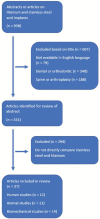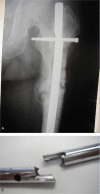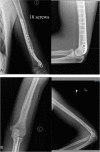A systematic review of the use of titanium versus stainless steel implants for fracture fixation
- PMID: 34746670
- PMCID: PMC8568430
- DOI: 10.1097/OI9.0000000000000138
A systematic review of the use of titanium versus stainless steel implants for fracture fixation
Abstract
Background: Controversy exists regarding the use of titanium and stainless steel implants in fracture surgery. To our knowledge, no recent, comprehensive review on this topic has been reported.
Purpose: To perform a systematic review of the evidence in the current literature comparing differences between titanium and stainless steel implants for fracture fixation.
Methods: A systematic review of original research articles was performed through the PubMed database using PRISMA guidelines. Inclusion criteria were English-language studies comparing titanium and stainless steel implants in orthopaedic surgery, and outcome data were extracted.
Results: The search returned 938 studies, with 37 studies meeting our criteria. There were 12 clinical research articles performed using human subjects, 11 animal studies, and 14 biomechanical studies. Clinical studies of the distal femur showed the stainless steel cohorts had significantly decreased callus formation and an increased odds radio (OR 6.3, 2.7-15.1; P < .001) of nonunion when compared with the titanium plate cohorts. In the distal radius, 3 clinical trials showed no implant failures in either group, and no difference in incidence of plate removal, or functional outcome. Three clinical studies showed a slightly increased odds ratio of locking screw breakage with stainless steel intramedullary nails compared with titanium intramedullary nails (OR 1.52, CI 1.1-2.13).
Conclusion: Stainless steel implants have equal or superior biomechanical properties when compared with titanium implants. However, there is clinical evidence that titanium plates have a lower rate of failure and fewer complications than similar stainless steel implants in some situations. Although our review supports the use of titanium implants in these clinical scenarios, we emphasize that further prospective, comparative clinical studies are required before the conclusions can be made.
Keywords: clinical evidence; fracture fixation; stainless steel; titanium.
Copyright © 2021 The Authors. Published by Wolters Kluwer Health, Inc. on behalf of the Orthopaedic Trauma Association.
Conflict of interest statement
The authors have no conflicts of interest to disclose.
Figures




Similar articles
-
Biomechanical Comparison of Volar Fixed-Angle Locking Plates for AO C3 Distal Radius Fractures: Titanium Versus Stainless Steel With Compression.J Hand Surg Am. 2015 Oct;40(10):2032-8. doi: 10.1016/j.jhsa.2015.06.098. Epub 2015 Aug 5. J Hand Surg Am. 2015. PMID: 26253601
-
Implant Material, Type of Fixation at the Shaft, and Position of Plate Modify Biomechanics of Distal Femur Plate Osteosynthesis.J Orthop Trauma. 2017 Aug;31(8):e241-e246. doi: 10.1097/BOT.0000000000000860. J Orthop Trauma. 2017. PMID: 28394844
-
Biomechanical comparison between stainless steel, titanium and carbon-fiber reinforced polyetheretherketone volar locking plates for distal radius fractures.Orthop Traumatol Surg Res. 2018 Oct;104(6):877-882. doi: 10.1016/j.otsr.2018.05.002. Epub 2018 May 25. Orthop Traumatol Surg Res. 2018. PMID: 29807189
-
[Titanium or steel as osteosynthesis material : Systematic literature search for clinical evidence].Unfallchirurg. 2017 Feb;120(2):96-102. doi: 10.1007/s00113-016-0299-5. Unfallchirurg. 2017. PMID: 28108750 Review. German.
-
[Susceptibility to infections and behavior of stainless steel : Comparison with titanium implants in traumatology].Unfallchirurg. 2017 Feb;120(2):110-115. doi: 10.1007/s00113-016-0300-3. Unfallchirurg. 2017. PMID: 28070629 Review. German.
Cited by
-
Reduced Cell Adhesion on LightPLAS-Coated Implant Surfaces in a Three-Dimensional Bioreactor System.Int J Mol Sci. 2023 Jul 18;24(14):11608. doi: 10.3390/ijms241411608. Int J Mol Sci. 2023. PMID: 37511369 Free PMC article.
-
Assessing Microleakage at 2 Different Implant-Healing Abutment Interfaces.Int Dent J. 2023 Jun;73(3):370-376. doi: 10.1016/j.identj.2022.07.010. Epub 2022 Sep 6. Int Dent J. 2023. PMID: 36075760 Free PMC article.
-
Advancements in Nanotechnology for Spinal Surgery: Innovations in Spinal Fixation Devices for Enhanced Biomechanical Performance and Osteointegration.Nanomaterials (Basel). 2025 Jul 10;15(14):1073. doi: 10.3390/nano15141073. Nanomaterials (Basel). 2025. PMID: 40711192 Free PMC article. Review.
-
Advances in Multifunctional Bioactive Coatings for Metallic Bone Implants.Materials (Basel). 2022 Dec 25;16(1):183. doi: 10.3390/ma16010183. Materials (Basel). 2022. PMID: 36614523 Free PMC article. Review.
-
Peri-Implant Fracture After Distal Femur Percutaneous Epiphysiodesis Using Transphyseal Screws.J Pediatr Soc North Am. 2024 Feb 12;5(2):684. doi: 10.55275/JPOSNA-2023-684. eCollection 2023 May. J Pediatr Soc North Am. 2024. PMID: 40433516 Free PMC article.
References
-
- Marcomini JB, Baptista CA, Pascon JP, et al. Investigation of a fatigue failure in a stainless steel femoral plate. J Mech Behav Biomed Mater. 2014;38:52–58. - PubMed
-
- Lujan TJ, Henderson CE, Madey SM, et al. Locked plating of distal femur fractures leads to inconsistent and asymmetric callus formation. J Orthop Trauma. 2010;24:156–162. - PubMed
-
- Chen YQ, Dai KR, Qiu SJ, et al. Bone remodelling after internal fixation with different stiffness plates: ultrastructural investigation. Chin Med J. 1994;107:766–770. - PubMed
-
- Disegi JA. Titanium alloys for fracture fixation implants. Injury. 2000;31 suppl 4:14–17. - PubMed
LinkOut - more resources
Full Text Sources
